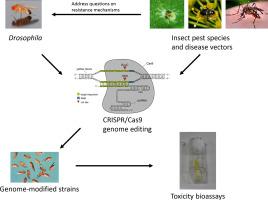当前位置:
X-MOL 学术
›
Pestic. Biochem. Phys.
›
论文详情
Our official English website, www.x-mol.net, welcomes your
feedback! (Note: you will need to create a separate account there.)
Using CRISPR/Cas9 genome modification to understand the genetic basis of insecticide resistance: Drosophila and beyond
Pesticide Biochemistry and Physiology ( IF 4.2 ) Pub Date : 2020-07-01 , DOI: 10.1016/j.pestbp.2020.104595 Vassilis Douris 1 , Shane Denecke 2 , Thomas Van Leeuwen 3 , Chris Bass 4 , Ralf Nauen 5 , John Vontas 6
Pesticide Biochemistry and Physiology ( IF 4.2 ) Pub Date : 2020-07-01 , DOI: 10.1016/j.pestbp.2020.104595 Vassilis Douris 1 , Shane Denecke 2 , Thomas Van Leeuwen 3 , Chris Bass 4 , Ralf Nauen 5 , John Vontas 6
Affiliation

|
Chemical insecticides are a major tool for the control of many of the world's most damaging arthropod pests. However, their intensive application is often associated with the emergence of resistance, sometimes with serious implications for sustainable pest control. To mitigate failure of insecticide-based control tools, the mechanisms by which insects have evolved resistance must be elucidated. This includes both identification and functional characterization of putative resistance genes and/or mutations. Research on this topic has been greatly facilitated by using powerful genetic model insects like Drosophila melanogaster, and more recently by advances in genome modification technology, notably CRISPR/Cas9. Here, we present the advances that have been made through the application of genome modification technology in insecticide resistance research. The majority of the work conducted in the field to date has made use of genetic tools and resources available in D. melanogaster. This has greatly enhanced our understanding of resistance mechanisms, especially those mediated by insensitivity of the pesticide target-site. We discuss this progress for a series of different insecticide targets, but also report a number of unsuccessful or inconclusive attempts that highlight some inherent limitations of using Drosophila to characterize resistance mechanisms identified in arthropod pests. We also discuss an experimental framework that may circumvent current limitations while retaining the genetic versatility and robustness that Drosophila has to offer. Finally, we describe examples of direct CRISPR/Cas9 use in non-model pest species, an approach that will likely find much wider application in the near future.
中文翻译:

使用 CRISPR/Cas9 基因组修饰来了解杀虫剂抗性的遗传基础:果蝇及其他
化学杀虫剂是控制世界上许多最具破坏性的节肢动物害虫的主要工具。然而,它们的密集应用往往与抗性的出现有关,有时会对可持续的害虫控制产生严重的影响。为了减轻基于杀虫剂的控制工具的失败,必须阐明昆虫进化出抗性的机制。这包括推定的抗性基因和/或突变的鉴定和功能表征。使用强大的遗传模式昆虫(如黑腹果蝇)以及最近基因组修饰技术(尤其是 CRISPR/Cas9)的进步极大地促进了对该主题的研究。这里,我们介绍了通过在杀虫剂抗性研究中应用基因组修饰技术而取得的进展。迄今为止在该领域进行的大部分工作都利用了黑腹果蝇中可用的遗传工具和资源。这极大地增强了我们对抗性机制的理解,尤其是那些由农药靶位点不敏感引起的抗性机制。我们讨论了一系列不同杀虫剂目标的这一进展,但也报告了一些不成功或不确定的尝试,这些尝试强调了使用果蝇来表征节肢动物害虫中确定的抗性机制的一些固有局限性。我们还讨论了一个实验框架,它可以规避当前的限制,同时保留果蝇必须提供的遗传多样性和稳健性。最后,
更新日期:2020-07-01
中文翻译:

使用 CRISPR/Cas9 基因组修饰来了解杀虫剂抗性的遗传基础:果蝇及其他
化学杀虫剂是控制世界上许多最具破坏性的节肢动物害虫的主要工具。然而,它们的密集应用往往与抗性的出现有关,有时会对可持续的害虫控制产生严重的影响。为了减轻基于杀虫剂的控制工具的失败,必须阐明昆虫进化出抗性的机制。这包括推定的抗性基因和/或突变的鉴定和功能表征。使用强大的遗传模式昆虫(如黑腹果蝇)以及最近基因组修饰技术(尤其是 CRISPR/Cas9)的进步极大地促进了对该主题的研究。这里,我们介绍了通过在杀虫剂抗性研究中应用基因组修饰技术而取得的进展。迄今为止在该领域进行的大部分工作都利用了黑腹果蝇中可用的遗传工具和资源。这极大地增强了我们对抗性机制的理解,尤其是那些由农药靶位点不敏感引起的抗性机制。我们讨论了一系列不同杀虫剂目标的这一进展,但也报告了一些不成功或不确定的尝试,这些尝试强调了使用果蝇来表征节肢动物害虫中确定的抗性机制的一些固有局限性。我们还讨论了一个实验框架,它可以规避当前的限制,同时保留果蝇必须提供的遗传多样性和稳健性。最后,











































 京公网安备 11010802027423号
京公网安备 11010802027423号